Index to Flowers in the Order Asparagales
Family: Amaryllidaceae
Agapanthus praecox Common Agapanthus, Blue Lily viewtopic.php?p=224232#p224232
Ammocharis coranica Ground Lily, Tumbleweed, Karoo Lily viewtopic.php?f=248&t=317&p=170710#p170710
Boophone disticha Bushman Poison Bulb viewtopic.php?p=211306#p211306
Brunsvigia orientalis Candelabra Flower viewtopic.php?p=261006#p261006
Clivia miniata miniata Bush Lily, Clivia viewtopic.php?p=210930#p210930
Crinum buphanoides Sand Lily, Boophane Crinum Lily viewtopic.php?f=248&t=317&p=186796#p186796
Crinum macowanii River Lily, Common Vlei Crinum viewtopic.php?f=248&t=317&p=181164#p181164
Crinum stuhlmannii, Crinum delagoense Candy-striped Crinum viewtopic.php?f=248&t=317&p=170712#p170712
Nerine laticoma Vlei Lily viewtopic.php?p=489356#p489356
Pancratium tenuifolium Vlei Lily viewtopic.php?p=488581#p488581
Scadoxus multiflorus Blood Flower, Fire-ball Lily viewtopic.php?f=248&p=170713#p170713
Scadoxus puniceus Blood Lily viewtopic.php?p=252563#p252563
Family: Asparagaceae
Lachenalia violacea Karoo Lachenalia viewtopic.php?p=195807#p195807
Massonia depressa Common Hedgehog Lily viewtopic.php?p=204706#p204706
Sansevieria hyacinthoides Mother-In-Laws-Tongue, Piles Root viewtopic.php?f=248&t=317&p=170718#p170718
Family: Hyacinthaceae
Albuca canadensis, Ornithogalum canadense Soldier-in-a-box, Wittamarak, Gambry viewtopic.php?f=248&t=317&p=170716#p170716
Albuca consanguinea, Ornithogalum polyphyllum Albuca viewtopic.php?f=248&p=170714#p170714
Albuca cooperi Albuca viewtopic.php?f=248&p=170715#p170715
Albuca flaccida Slime Lily viewtopic.php?p=240929#p240929
Albuca seineri Bushveld Chincherinchee viewtopic.php?f=248&p=170717#p170717
Drimia altissima Tall White Squill viewtopic.php?p=257932#p257932
Empodium gloriosum Autumn Star viewtopic.php?p=528757#p528757
Ornithogalum thyrsoides Chincherinchee viewtopic.php?p=235719#p235719
Pseudogaltonia clavata Cape Hyacinth viewtopic.php?p=255892#p255892
Family: Hypoxidaceae
Hypoxis hemerocallidea, Hypoxis rooperi Star-flower, Yellow Star Hairy Star-flower viewtopic.php?f=248&t=317&p=170719#p170719
Family: Iridaceae
Aristea africana Short Aristea viewtopic.php?p=301588#p301588
Aristea capitata Blue Sceptre viewtopic.php?p=313851#p313851
Babiana ambigua Blue Babiana, Purple Baboon Root viewtopic.php?f=248&t=317&p=170720#p170720
Babiana patersoniae Blue Crocus viewtopic.php?f=248&t=317&p=178067#p178067
Crocosmia aurea aurea Falling Stars, Montbretia viewtopic.php?p=276648#p276648
Dietes grandiflora Large Wild Iris, Fairy Iris viewtopic.php?f=248&t=317&p=170721#p170721
Dietes iridioides Wood Iris viewtopic.php?p=533570#p533570
Gladiolus brachyphyllus viewtopic.php?p=261337#p261337
Gladiolus saccatus viewtopic.php?f=248&t=317&p=170722#p170722
Lapeirousia fabricii Painted Petals, Kabong viewtopic.php?p=196900#p196900
Moraea bifida viewtopic.php?f=248&t=317&p=170723#p170723
Moraea miniata Two-leaf Cape-tulip viewtopic.php?p=235704#p235704
Watsonia confusa Bugle Lily viewtopic.php?f=248&t=317&p=170724#p170724
Watsonia lepida Drakensberg Watsonia viewtopic.php?p=301405#p301405
Watsonia pillansii Large Orange Watsonia viewtopic.php?p=242080#p242080
Family: Orchidaceae
Ansellia africana Leopard Orchid viewtopic.php?f=248&t=317&p=170725#p170725
Pterygodium orobanchoides, Corycium orobanchoides Common Monkshood Orchid viewtopic.php?p=229486#p229486
Superfamily: Xanthorrhoeacea. Family: Asphodelaceae
Aloe chabaudii Chabaud's Aloe viewtopic.php?f=248&p=170726#p170726
Aloe ecklonis, Aloe kraussii, Aloe boylei Grass Aloe viewtopic.php?f=248&t=317&p=170727#p170727
Aloe pearsonii Pearson's Aloe viewtopic.php?f=248&t=317&p=171992#p171992
Aloe vanbalenii Van Balen's Aloe viewtopic.php?f=248&t=317&start=20#p171994
Bulbine abyssinica Bushy Bulbine viewtopic.php?f=248&t=317&start=20#p171995
Bulbine sp. nova viewtopic.php?f=248&t=317&start=20#p171997
Africa Wild Flower Book - Order Asparagales
Moderator: Klipspringer
Re: Africa Wild Flower Book - Order Asparagales
Ground Lily, Tumbleweed, Karoo Lily Ammocharis coranica
Order Asparagales. Family Amaryllidaceae
 © Alf
© Alf
Kruger National Park, Mopani area, Dec 2018
 © Puff Addy
© Puff Addy
Mountain Zebra National Park
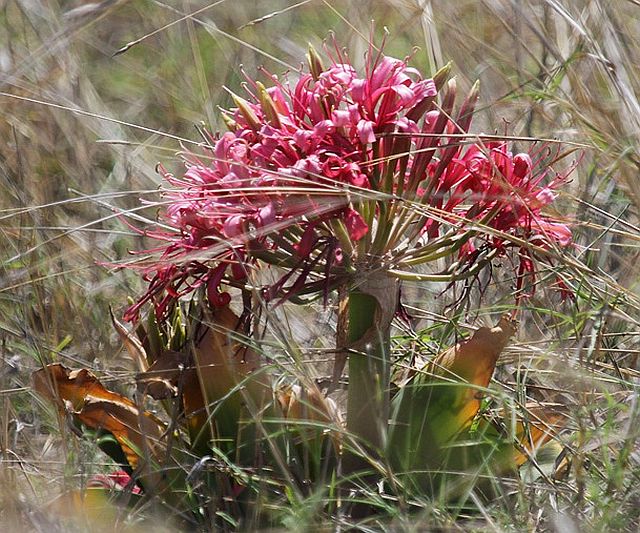 © leachy
© leachy
Kruger National Park, H1-8
 © aat
© aat
Kruger National Park
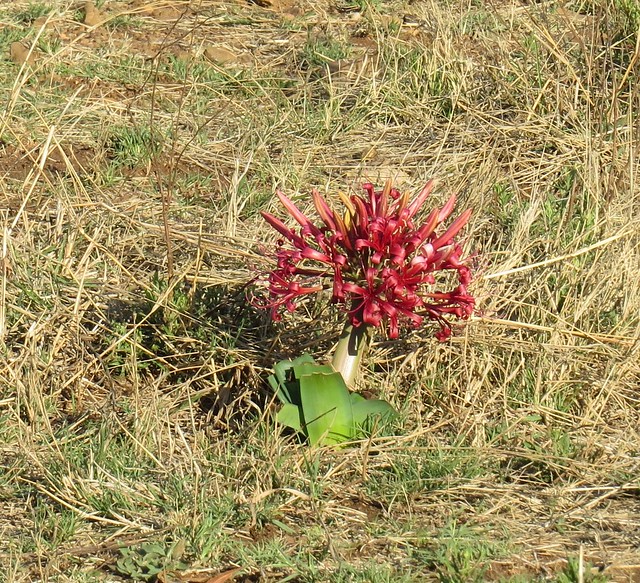 © steamtrainfan
© steamtrainfan
Pilanesberg
Description
A deciduous perennial with a large bulb, up to 20 cm; usually in groups. Leaves radiating on or near the ground. Leaves in a basal rosette, often with a "cut-off" look, due to grazing by wildlife or cattle. Flowers in a large terminal umbel, pink to carmine.
Distribution
It occurs throughout the Karoo and its range extends into the eastern grassland of the summer rainfall area of South Africa, it extends into Zimbabwe through to Kenya in east Africa. Provincial distribution: Eastern Cape, Free State, Gauteng, KwaZulu-Natal, Limpopo, Mpumalanga, Northern Cape, North West, Western Cape. It may be seen flowering during November to December practically anywhere in the Kruger National Park.
Habitat
It occurs in grassland. bushveld and karroid vegetation at altitudes between 700 and 1500 metres on flats or in depressions which are seasonally wet, although its habitat is characterised by lengthy dry periods and severe droughts. Often in brackish patches near pans.
Order Asparagales. Family Amaryllidaceae
Kruger National Park, Mopani area, Dec 2018
 © Puff Addy
© Puff AddyMountain Zebra National Park
 © leachy
© leachyKruger National Park, H1-8
 © aat
© aatKruger National Park
 © steamtrainfan
© steamtrainfanPilanesberg
Description
A deciduous perennial with a large bulb, up to 20 cm; usually in groups. Leaves radiating on or near the ground. Leaves in a basal rosette, often with a "cut-off" look, due to grazing by wildlife or cattle. Flowers in a large terminal umbel, pink to carmine.
Distribution
It occurs throughout the Karoo and its range extends into the eastern grassland of the summer rainfall area of South Africa, it extends into Zimbabwe through to Kenya in east Africa. Provincial distribution: Eastern Cape, Free State, Gauteng, KwaZulu-Natal, Limpopo, Mpumalanga, Northern Cape, North West, Western Cape. It may be seen flowering during November to December practically anywhere in the Kruger National Park.
Habitat
It occurs in grassland. bushveld and karroid vegetation at altitudes between 700 and 1500 metres on flats or in depressions which are seasonally wet, although its habitat is characterised by lengthy dry periods and severe droughts. Often in brackish patches near pans.
Re: Africa Wild Flower Book - Order Asparagales
Candy-striped Swamplily Crinum stuhlmannii, formerly: Crinum delagoense (Gestreepte Vleilelie)
Order: Asparagales. Family: Amaryllidaceae
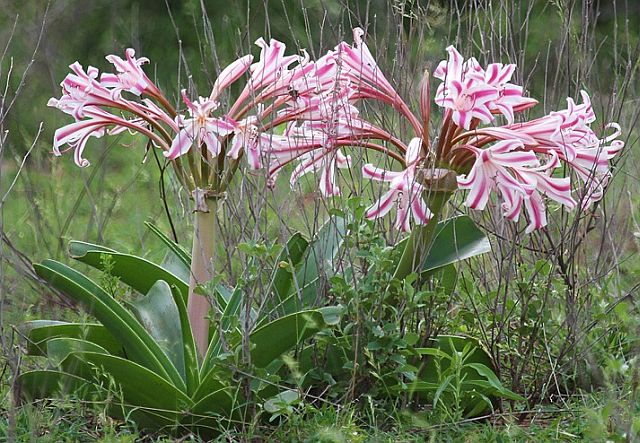 © leachy
© leachy
Kruger National Park
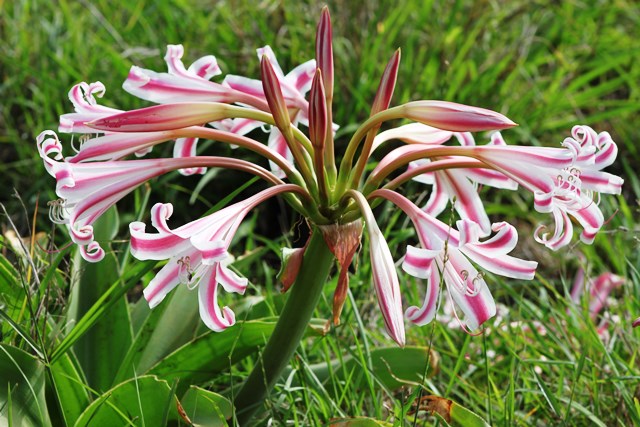 © Heksie
© Heksie
Kruger National Park
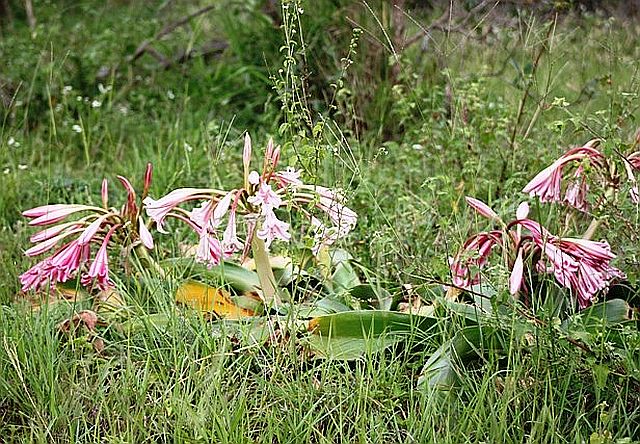 © Heksie
© Heksie
Kruger National Park
Description
Bold, candy-striped trumpets and round red fruits are characteristic of this stunning Crinum. Bulbous perennial. Leaves broad, spreading and flat, up to 100 × 20 cm; margin finely hairy. Flowers in many-flowered umbels (up to 50), flared, white with deep pink ribs. Fruit up to 7 cm in diameter, pinkish-red, not beaked.
Distribution
The species occurs from KwaZulu-Natal to East Africa along the coastal region and along the low-altitude Zambezi and Limpopo Valleys. KwaZulu-Natal, Mpumalanga, Limpopo, eSwatini and Mozambique.
Habitat
In grassland, deciduous woodland, in low-altitude bushveldusually on sandy soils.
Kruger National Park, Orpen © mposthumus
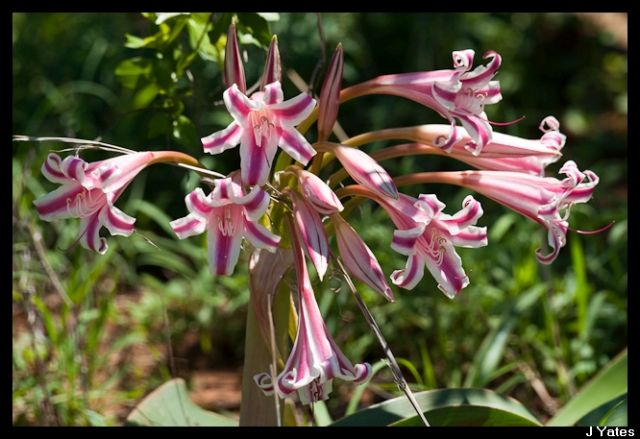 © Kesheshe
© Kesheshe
Kruger National Park
Links:
https://www.zimbabweflora.co.zw/species ... _id=114990
Order: Asparagales. Family: Amaryllidaceae
 © leachy
© leachyKruger National Park
 © Heksie
© HeksieKruger National Park
 © Heksie
© HeksieKruger National Park
Description
Bold, candy-striped trumpets and round red fruits are characteristic of this stunning Crinum. Bulbous perennial. Leaves broad, spreading and flat, up to 100 × 20 cm; margin finely hairy. Flowers in many-flowered umbels (up to 50), flared, white with deep pink ribs. Fruit up to 7 cm in diameter, pinkish-red, not beaked.
Distribution
The species occurs from KwaZulu-Natal to East Africa along the coastal region and along the low-altitude Zambezi and Limpopo Valleys. KwaZulu-Natal, Mpumalanga, Limpopo, eSwatini and Mozambique.
Habitat
In grassland, deciduous woodland, in low-altitude bushveldusually on sandy soils.
Kruger National Park, Orpen © mposthumus
 © Kesheshe
© KeshesheKruger National Park
Links:
https://www.zimbabweflora.co.zw/species ... _id=114990
- Flutterby
- Posts: 44028
- Joined: Sat May 19, 2012 12:28 pm
- Country: South Africa
- Location: Gauteng, South Africa
- Contact:
Re: Africa Wild Flower Book - Order Asparagales
Blood Flower, Fire-ball Lily Scadoxus multiflorus
Order: Asparagales. Family: Amaryllidaceae
 © Flutterby
© Flutterby
Kruger National Park, close to Sable Dam
Description
Scadoxus multiflorus is a decidious plant with simple leaves. The leaves appear at the base of the plant. The flowerhead consists of up to 200 flowers, held clear of the foliage at the end of a solitary stem. Each plant will produce only one flowerhead in a season. A flowerhead can reach a diameter of 25 cm and a height of 110 cm, nearly waist height. Each flower is pinkish-orange-red with protruding stamens carrying bright yellow anthers. The flowerheads last for 1 or 2 weeks and make superb cut flowers. Flowering is in late summer to early autumn. Shiny red fruit.
Distribution
Scadoxus multiflorus has a wide distribution and varying habitat and is found predominantly in tropical Africa but its range extends from the Eastern Cape in South Africa, through KwaZulu-Natal, all four northern provinces of South Africa, into Swaziland, Mozambique, Zimbabwe, Namibia and Botswana and throughout all but the very driest regions of tropical Africa.
Habitat
It occurs in lowland to mountain forest, secondary forest, forest margins, savannah woodland, open grassland and is very common in the shade of trees at river banks.
 © Super Mongoose
© Super Mongoose
 © Super Mongoose
© Super Mongoose
Ndumo Game Reserve, KwaZulu-Natal
 © aat
© aat
Kruger National Park
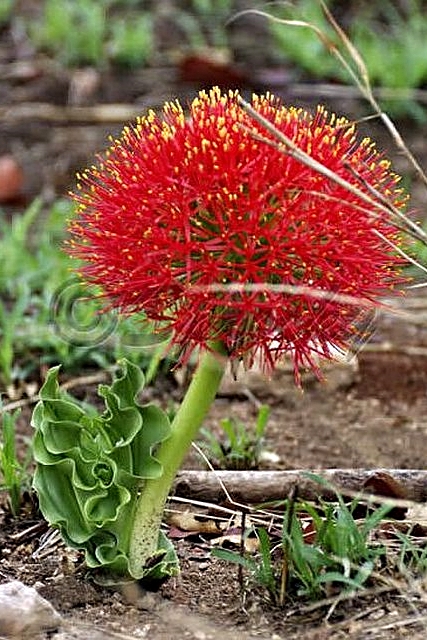 © Sprocky
© Sprocky
Kruger National Park
Order: Asparagales. Family: Amaryllidaceae
 © Flutterby
© FlutterbyKruger National Park, close to Sable Dam
Description
Scadoxus multiflorus is a decidious plant with simple leaves. The leaves appear at the base of the plant. The flowerhead consists of up to 200 flowers, held clear of the foliage at the end of a solitary stem. Each plant will produce only one flowerhead in a season. A flowerhead can reach a diameter of 25 cm and a height of 110 cm, nearly waist height. Each flower is pinkish-orange-red with protruding stamens carrying bright yellow anthers. The flowerheads last for 1 or 2 weeks and make superb cut flowers. Flowering is in late summer to early autumn. Shiny red fruit.
Distribution
Scadoxus multiflorus has a wide distribution and varying habitat and is found predominantly in tropical Africa but its range extends from the Eastern Cape in South Africa, through KwaZulu-Natal, all four northern provinces of South Africa, into Swaziland, Mozambique, Zimbabwe, Namibia and Botswana and throughout all but the very driest regions of tropical Africa.
Habitat
It occurs in lowland to mountain forest, secondary forest, forest margins, savannah woodland, open grassland and is very common in the shade of trees at river banks.
 © Super Mongoose
© Super Mongoose © Super Mongoose
© Super MongooseNdumo Game Reserve, KwaZulu-Natal
 © aat
© aatKruger National Park
 © Sprocky
© SprockyKruger National Park
- nan
- Posts: 26441
- Joined: Thu May 31, 2012 9:41 pm
- Country: Switzerland
- Location: Central Europe
- Contact:
Re: Africa Wild Flower Book - Order Asparagales
Albuca sp. Albuca consanguinea, Ornithogalum polyphyllum (Groottjink)
Order: Asparagales. Family: Asparagaceae. Subfamily: Scilloideae
(Also treated as the family Hyacinthaceae)
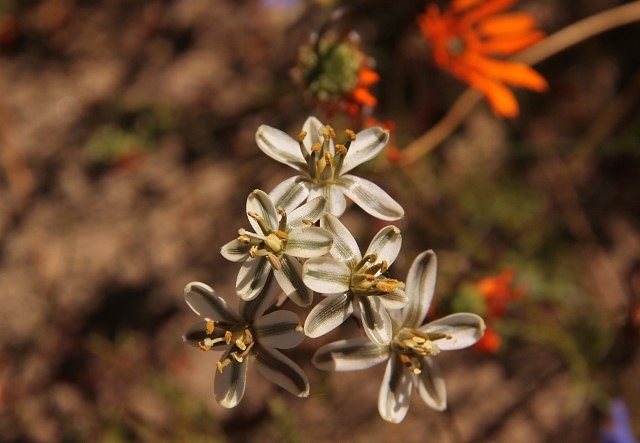
Description
Perennial herb - 60 cm high. Basal leaves are erect, linear to almost cylindrical, up to 25 cm high. Numerous flowers, 3 cm in diameter. White with green stripes, borne loosely in the flower-head.
Distribution
South African endemic. Provincial distribution: Northern Cape, Western Cape.
Order: Asparagales. Family: Asparagaceae. Subfamily: Scilloideae
(Also treated as the family Hyacinthaceae)

Description
Perennial herb - 60 cm high. Basal leaves are erect, linear to almost cylindrical, up to 25 cm high. Numerous flowers, 3 cm in diameter. White with green stripes, borne loosely in the flower-head.
Distribution
South African endemic. Provincial distribution: Northern Cape, Western Cape.
Kgalagadi lover… for ever
https://safrounet.piwigo.com/
https://safrounet.piwigo.com/
- nan
- Posts: 26441
- Joined: Thu May 31, 2012 9:41 pm
- Country: Switzerland
- Location: Central Europe
- Contact:
Re: Africa Wild Flower Book - Order Asparagales
Albuca sp. Albuca cooperi (Geldbeursie)
Order: Asparagales. Family: Asparagaceae
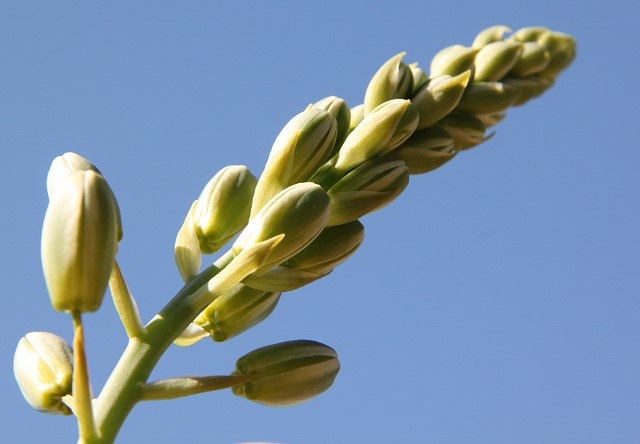
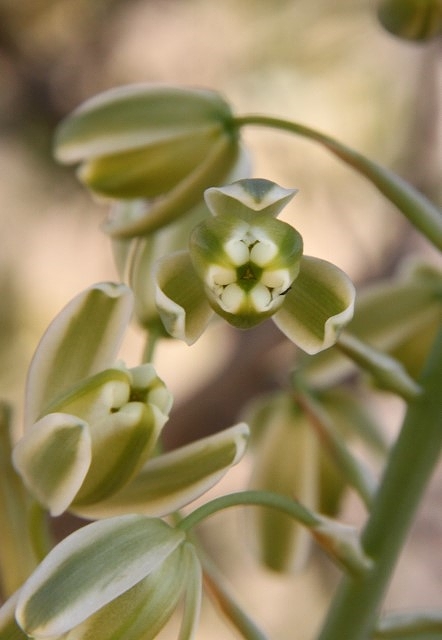

Description
Bulbous perennial, 35-60 cm, with the outer bulb tunics decaying into fibres at the top, and 2 or 3 slender, channelled leaves that clasp the stem in the lower part and are warty towards the base. Flowers are nodding, sweetly scented, yellow with green keels. Flowering is from September to January.
Distribution
Not endemic to South Africa. Namaqualand, western Karoo, Cape Peninsula to the southeastern Cape. Provincial distribution: Eastern Cape, Northern Cape, Western Cape.
Order: Asparagales. Family: Asparagaceae



Description
Bulbous perennial, 35-60 cm, with the outer bulb tunics decaying into fibres at the top, and 2 or 3 slender, channelled leaves that clasp the stem in the lower part and are warty towards the base. Flowers are nodding, sweetly scented, yellow with green keels. Flowering is from September to January.
Distribution
Not endemic to South Africa. Namaqualand, western Karoo, Cape Peninsula to the southeastern Cape. Provincial distribution: Eastern Cape, Northern Cape, Western Cape.
Kgalagadi lover… for ever
https://safrounet.piwigo.com/
https://safrounet.piwigo.com/
Re: Africa Wild Flower Book - Order Asparagales
Soldier-in-a-box, Wittamarak, Gambry Albuca canadensis, Ornithogalum canadense (Geldbeursie, Lanternblom, Slymstok)
Order: Asparagales. Family: Asparagaceae. Tribe: Hyacintheae
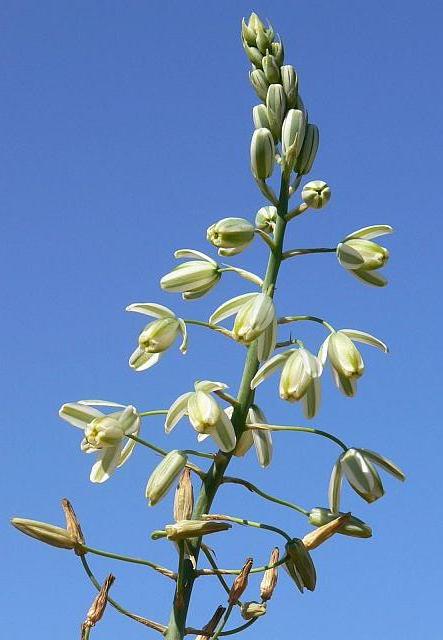
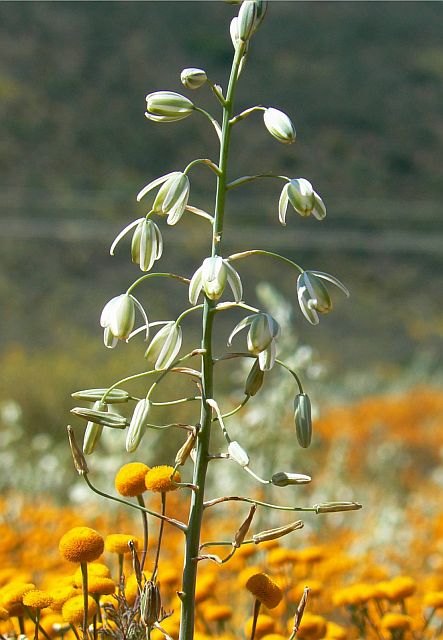

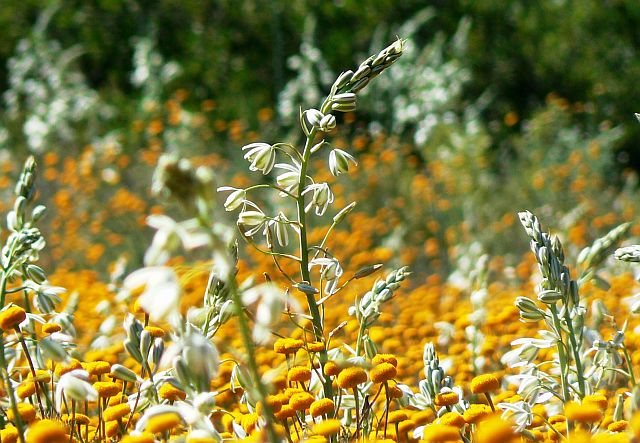
Cederberg
Description
Bulnous perenniel, 40-150 cm, with the outer bulb tunics slightly fribrous at the top, and 4 - 6 fleshy chenneled leaves, that clasp the stem below; bears racemes of weakly nodding, white flowers with broad green bands, 15-25 mm long, the inner petals have a hinged flap at the tip and the outer stamens are sterile. Flowering September to November.
Distribution
Namaqualand to the southern Cape (Northern Cape, Western Cape).
Habitat
Rocky sanstone or granitic soils. Coastal sandy soils.
Order: Asparagales. Family: Asparagaceae. Tribe: Hyacintheae




Cederberg
Description
Bulnous perenniel, 40-150 cm, with the outer bulb tunics slightly fribrous at the top, and 4 - 6 fleshy chenneled leaves, that clasp the stem below; bears racemes of weakly nodding, white flowers with broad green bands, 15-25 mm long, the inner petals have a hinged flap at the tip and the outer stamens are sterile. Flowering September to November.
Distribution
Namaqualand to the southern Cape (Northern Cape, Western Cape).
Habitat
Rocky sanstone or granitic soils. Coastal sandy soils.
- Flutterby
- Posts: 44028
- Joined: Sat May 19, 2012 12:28 pm
- Country: South Africa
- Location: Gauteng, South Africa
- Contact:
Re: Africa Wild Flower Book - Order Asparagales
Bushveld Chincherinchee Albuca seineri
Order: Asparagales. Family: Asparagaceae

Kruger National Park, on the H4-1
 © Super Mongoose
© Super Mongoose
Kruger National Park, H1-3 South of Nkaya Pan
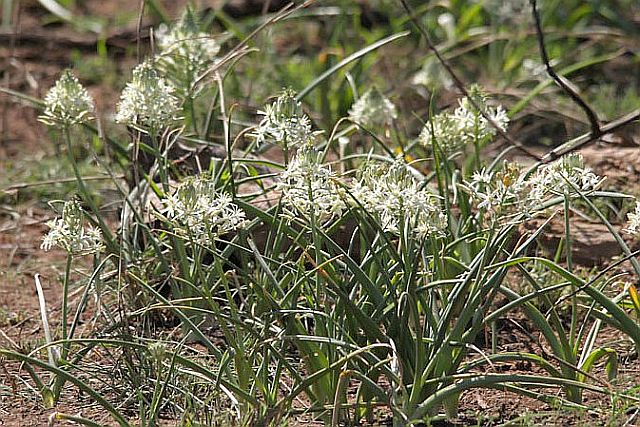 © Super Mongoose
© Super Mongoose
Kruger National Park, H1-3 South of Nkaya Pan
 © nan
© nan
Kgalagadi Transfrontier Park, Northern Cape
Description
A bulbous plant, up to 500 mm high, with an elongated or egg-shaped bulb covered with a firm, dark outer tunic forming a short neck. Leaves about 7, linear slender and blue-green to dark green. Leaves are speckled dark below. Inflorescence round or pyramidal. Flowers up to 15 mm diameter.
Distribution
Free State, Limpopo, Mpumalanga, Northern Cape, Namibia.
Habitat
These plants form spectacular colonies in open, dry grassland. Common in sandy soil in dune streets and river terraces in the Kalahari. Mass flowering occurs after the first rains in spring or early summer.
Order: Asparagales. Family: Asparagaceae

Kruger National Park, on the H4-1
 © Super Mongoose
© Super MongooseKruger National Park, H1-3 South of Nkaya Pan
 © Super Mongoose
© Super MongooseKruger National Park, H1-3 South of Nkaya Pan
 © nan
© nanKgalagadi Transfrontier Park, Northern Cape
Description
A bulbous plant, up to 500 mm high, with an elongated or egg-shaped bulb covered with a firm, dark outer tunic forming a short neck. Leaves about 7, linear slender and blue-green to dark green. Leaves are speckled dark below. Inflorescence round or pyramidal. Flowers up to 15 mm diameter.
Distribution
Free State, Limpopo, Mpumalanga, Northern Cape, Namibia.
Habitat
These plants form spectacular colonies in open, dry grassland. Common in sandy soil in dune streets and river terraces in the Kalahari. Mass flowering occurs after the first rains in spring or early summer.
Re: Africa Wild Flower Book - Order Asparagales
Mother-In-Laws-Tongue, Piles Root Sansevieria hyacinthoides, Sansevieria thyrsiflora Aambeiwortel, Skoonma-se-tong
Order: Asparagales. Family: Asparagaceae (formerly Dracaenaceae)
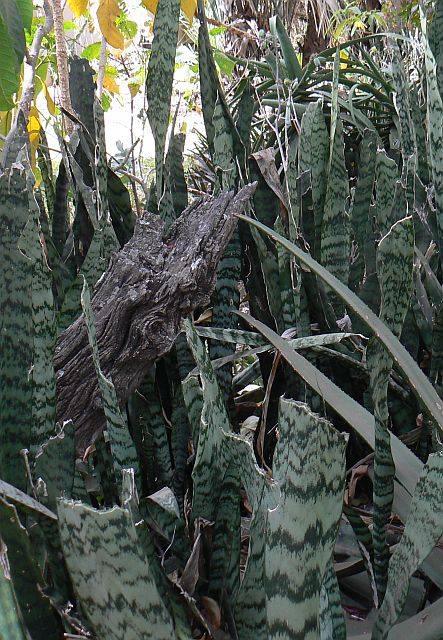

Kruger National Park, Letaba
Description
Acaulescent perennials forming large colonies; up to 60 cm tall. Rhizome subterranean. Leaves are dark green with paler irregular horizontal markings, flat to somewhat incurved, margin white or red. It is particularly pretty when in flower, the tall inflorescence is 65–70 cm long and carries greenish white to pale mauve, lightly scented blooms. The berries which follow the flowers are orange or yellow.
Sanseviera aethiopica and S. hyacinthoides can not readily be distinguished in the veld.
Distribution
Malawi, Mozambique, Zambia, Zimbabwe, Swaziland, South Africa (Provincial distribution: Eastern Cape, Gauteng, KwaZulu-Natal, Limpopo, Mpumalanga).
Habitat
The habitat is in summer rainfall area sandy soil, often among granite hills and outcrops.
Links: Swaziland's Flora Database
Order: Asparagales. Family: Asparagaceae (formerly Dracaenaceae)


Kruger National Park, Letaba
Description
Acaulescent perennials forming large colonies; up to 60 cm tall. Rhizome subterranean. Leaves are dark green with paler irregular horizontal markings, flat to somewhat incurved, margin white or red. It is particularly pretty when in flower, the tall inflorescence is 65–70 cm long and carries greenish white to pale mauve, lightly scented blooms. The berries which follow the flowers are orange or yellow.
Sanseviera aethiopica and S. hyacinthoides can not readily be distinguished in the veld.
Distribution
Malawi, Mozambique, Zambia, Zimbabwe, Swaziland, South Africa (Provincial distribution: Eastern Cape, Gauteng, KwaZulu-Natal, Limpopo, Mpumalanga).
Habitat
The habitat is in summer rainfall area sandy soil, often among granite hills and outcrops.
Links: Swaziland's Flora Database
Re: Africa Wild Flower Book - Order Asparagales
Star-flower, Yellow Star Hairy Star-flower Hypoxis hemerocallidea, Hypoxis rooperi (Gifbol, Kaffertulp, Sterblom, Harige Sterblom)
Order: Asparagales. Family: Hypoxidaceae
 © Amoli
© Amoli
Rietvlei Nature Reserve, Gauteng
Flowers of the genus Hypoxis are herbaceous geophyte with a fibrous base and with a corm. Leaves basal, sessile, with a sheathing base; outermost reduced to cataphylls. Indumentum of 2-armed or stellate hairs. Inflorescence a raceme or corymb or flowers solitary. Flowers without a perianth tube. Tepals in two series of 3; yellow inside, hairy on the outer side. Fruit a capsule. Seeds not strophiolate, smooth or (often) papillose.
All species are deceptively similar while within each species shape and size of plants, leaves and flowers can be quite variable. This makes the species notoriously difficult to identify.
Description
Hypoxis hemerocallidea is a tuberous perennial with straplike leaves and yellow star-shaped flowers. The leaves are up to 400 mm long, neatly arranged one above the other in 3 ranks, broad, stiff and arching outwards with prominent ribs and tapering towards the tips. The lower surface of the leaves is densely hairy with white hairs. Leaves appear above ground in spring before the flowers. The flowers are carried on 5 or 6 slender erect inflorescences, each carrying 5–13 bright yellow, star-shaped flowers with 6 tepals. Six free stamens arise from the base of the tepals with prominent anthers. The style is short and fat, carrying the robust stigma. The flowers are short-lived and close at midday. Flowers open sequentially from the base to the apex. Usually 1–3 flowers are open at the same time, thus encouraging cross-pollination. The large dark brown tuber is covered with bristly hairs, and is bright yellow when freshly cut. It has an unpleasant bitter taste.
Seeds are hard, black, smooth and glossy.
Distribution
Widespread in the eastern part of southern Africa from the Eastern Cape to Botswana and Mozambique. Provincial distribution: Eastern Cape, Free State, Gauteng, KwaZulu-Natal, Limpopo, Mpumalanga, North West.
Habitat
Occurs in a wide range of habitats, including sandy hills on the margins of dune forests, open, rocky grassland, dry, stony, grassy slopes, mountain slopes and plateaus. Appears to be drought and fire tolerant. Major habitats are Albany Thicket, Grassland, Indian Ocean Coastal Belt, Savanna.
Links: Botanical Society of South Africa
Order: Asparagales. Family: Hypoxidaceae
 © Amoli
© AmoliRietvlei Nature Reserve, Gauteng
Flowers of the genus Hypoxis are herbaceous geophyte with a fibrous base and with a corm. Leaves basal, sessile, with a sheathing base; outermost reduced to cataphylls. Indumentum of 2-armed or stellate hairs. Inflorescence a raceme or corymb or flowers solitary. Flowers without a perianth tube. Tepals in two series of 3; yellow inside, hairy on the outer side. Fruit a capsule. Seeds not strophiolate, smooth or (often) papillose.
All species are deceptively similar while within each species shape and size of plants, leaves and flowers can be quite variable. This makes the species notoriously difficult to identify.
Description
Hypoxis hemerocallidea is a tuberous perennial with straplike leaves and yellow star-shaped flowers. The leaves are up to 400 mm long, neatly arranged one above the other in 3 ranks, broad, stiff and arching outwards with prominent ribs and tapering towards the tips. The lower surface of the leaves is densely hairy with white hairs. Leaves appear above ground in spring before the flowers. The flowers are carried on 5 or 6 slender erect inflorescences, each carrying 5–13 bright yellow, star-shaped flowers with 6 tepals. Six free stamens arise from the base of the tepals with prominent anthers. The style is short and fat, carrying the robust stigma. The flowers are short-lived and close at midday. Flowers open sequentially from the base to the apex. Usually 1–3 flowers are open at the same time, thus encouraging cross-pollination. The large dark brown tuber is covered with bristly hairs, and is bright yellow when freshly cut. It has an unpleasant bitter taste.
Seeds are hard, black, smooth and glossy.
Distribution
Widespread in the eastern part of southern Africa from the Eastern Cape to Botswana and Mozambique. Provincial distribution: Eastern Cape, Free State, Gauteng, KwaZulu-Natal, Limpopo, Mpumalanga, North West.
Habitat
Occurs in a wide range of habitats, including sandy hills on the margins of dune forests, open, rocky grassland, dry, stony, grassy slopes, mountain slopes and plateaus. Appears to be drought and fire tolerant. Major habitats are Albany Thicket, Grassland, Indian Ocean Coastal Belt, Savanna.
Links: Botanical Society of South Africa


